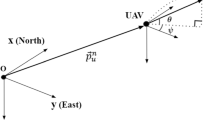Abstract
Recently, multi-UAV systems are attracting growing interests. It offers wide range of applications in civilian and military environment, carrying out dangerous missions that manned aircraft cannot offer. Currently, an important challenge is the collision avoidance algorithm. The idea is to use the collision avoidance algorithm to control the multi-UAV systems. This will guarantee the safety of the UAVs. The UAVs will complete the missions without colliding with any moving or static obstacles. This topic has motivated the development of various collision avoidance algorithms. In this paper, we proposed some improvements on the three-dimensional velocity obstacle algorithm proposed in Jenie et al. (J. Guid. Control Dyn. 39(10), 2312–2323 25). Our improvements are threefold. First, we indicate the limitations of the original 3D collision avoidance method and present the modifications on the algorithm. Second, we develop the velocity obstacle method to be capable of handling cube obstacles in 3D space. Third, a real flight test is conducted to verify the effectiveness of the proposed three-dimensional velocity obstacle method.
Similar content being viewed by others
Explore related subjects
Discover the latest articles, news and stories from top researchers in related subjects.References
Huang, S., Teo, R., Liu, W., Dymkou, S.M.: Distributed cooperative UAV loss detection and auto-replacement protocol with guaranteed properties. J. Intell. Robot. Syst. 93(1), 303–316 (2019)
Huang, S., Teo, R., Liu, W., Dymkou, S.M.: Agent model for multi-UAV control via protocol designs. Int. J. Intell. Comput. Cybern. 10(4), 412–429 (2017)
Zhang, G., Shang, B., Chen, Y.Q., Moyes, H.: SmartCaveDrone: 3D cave mapping using UAVs as robotic co-archaeologists. In: 2017 International Conference on Unmanned Aircraft Systems, pp 1052–1057. IEEE, Miami (2017)
Zhang, G., Chen, Y.Q., Moyes, H.: Optimal 3D reconstruction of caves using small unmanned aerial systems and GGB-D cameras. In: 2018 International Conference on Unmanned Aircraft Systems (ICUAS), pp 410–415. IEEE, Dallas (2018)
Chevet, T., Maniu, C.S., Vlad, C., Zhang, Y.: Voronoi-based UAVs formation deployment and reconfiguration using MPC techniques. In: 2018 International Conference on Unmanned Aircraft Systems (ICUAS), pp 9–14. IEEE, Dallas (2018)
Yu, X., Zhang, Y.: Sense and avoid technologies with applications to unmanned aircraft systems: Review and prospects. Progress Aeros. Sci. 74, 152–166 (2015)
Yu, X., Zhou, X., Zhang, Y.: Collision-free trajectory generation and tracking for UAVs using Markov decision process in a cluttered environment. J. Intell. Robot. Syst. 93(1–2), 17–32 (2019)
Zhou, X., Yu, X., Peng, X.: UAV collision avoidance based on varying cells strategy. IEEE Transactions on Aerospace and Electronic Systems, to be published, https://doi.org/10.1109/TAES.2018.2875556
Preiss, J.A., Hönig, W., Ayanian, N., Sukhatme, G.S.: Downwash-aware trajectory planning for large quadrotor teams, arXiv:1704.04852v2 [cs.RO] (2017)
Manathara, J.G., Ghose D.: Reactive collision avoidance of multiple realistic UAVs. Aircraft Eng. Aerosp. Technol. 83(6), 388–396 (2011)
Lalish, E., Morgansen, K.A.: Distributed reactive collision avoidance. Auton. Robots 32(3), 207–226 (2012)
Lao, M., Tang, J.: Cooperative multi-UAV collision avoidance based on distributed dynamic optimization and causal analysis. Appl. Sci. 7(1), 83 (2017)
Migliaccio, G., Mengali, G., Galatolo, R.: Conflict detection and resolution algorithms for UAVs collision avoidance. Aeronaut. J. 118(1205), 828–842 (2016)
Han, S.C., Bang, H., Yoo, C.S.: Proportional navigation-based collision avoidance for UAVs. Int. J. Control Autom. Syst. 7(4), 553–565 (2009)
Vera, S., Cobano, J.A., Heredia, G., Ollero, A.: Collision avoidance for multiple UAVs using rolling-horizon policy. J. Intell. Robot. Syst. 84(14), 387–396 (2016)
Budiyanto, A., Cahyadi, A., Adji, T.B., Wahyunggoro, O., Grafika, J.: UAV obstacle avoidance using potential field under dynamic environment. In: International Conference on Control, Electronics, Renewable Energy Communications, pp. 187–192 (2015)
Mac, T.T., Copot, C., Hernandez, A., De Keyser, R.: Improved potential field method for unknown obstacle avoidance using UAV in indoor environment. In: SAMI 2016 - IEEE 14th International Symposium Applied Machine Intelligence Informatics, pp. 345–350 (2016)
Huang, S., Swee, R., Teo, H., Liu, W., Dymkou, S.M.: Distributed cooperative collision avoidance control and implementation for multi-unmanned aerial vehicles. In: Proc. of 2017 11th Asian Control Conference (ASCC), pp. 222–227. Gold Coast (2017)
Tan, C.Y., Huang, S., Tan, K.K., Teo, S.H.R.: Three-dimensional cooperative collision avoidance design on unmanned aerial vehicle. In: 2018 International Conference on Unmanned Aircraft Systems, pp. 522–530. Dallas (2018)
Jenie, Y.I., Van Kampen, E.-J., de Visser, C.C., Ellerbroek, J., Hoekstra, J.M.: Selective velocity obstacle method for deconflicting maneuvers applied to unmanned aerial vehicles. J. Guid. Control Dyn., 38(6) (2015)
Kuwata, Y., Wolf, M.T., Zarzhitsky, D., Huntsberger, T.L.: Safe maritime navigation with COLREGS using velocity obstacles, 4728–4734 (2011)
Fiorini, P., Shiller, Z.: Motion planning in dynamic environments using velocity obstacles. I. J. Robot. Res 17, 760–772 (1998)
Chakravarthy, A., Ghose, D.: Obstacle avoidance in a dynamic environment: a collision cone approach. IEEE Trans. Syst. Man Cybern. Part A: Syst. Humans 28(5), 562–574 (1998)
Jenie, Y.I., van Kampen, E., de Visser, C.C., Ellerbroek, J., Hoekstra, J.M.: Three-dimensional velocity obstacle method for UAV deconflicting maneuvers. AIAA Guidance, Navigation and Control Conference, 116 (2016)
Jenie, Y.I., van Kampen, E.-J., de Visser, C.C., Ellerbroek, J., Hoekstra, J.M.: Three-dimensional velocity obstacle method for uncoordinated avoidance maneuvers of unmanned aerial vehicles. J. Guid. Control Dyn. 39(10), 2312–2323 (2016)
Author information
Authors and Affiliations
Corresponding author
Additional information
Publisher’s Note
Springer Nature remains neutral with regard to jurisdictional claims in published maps and institutional affiliations.
A short version of this paper was presented in ICUAS 2018.
Rights and permissions
About this article
Cite this article
Tan, C.Y., Huang, S., Tan, K.K. et al. Three Dimensional Collision Avoidance for Multi Unmanned Aerial Vehicles Using Velocity Obstacle. J Intell Robot Syst 97, 227–248 (2020). https://doi.org/10.1007/s10846-019-01055-5
Received:
Accepted:
Published:
Issue Date:
DOI: https://doi.org/10.1007/s10846-019-01055-5




